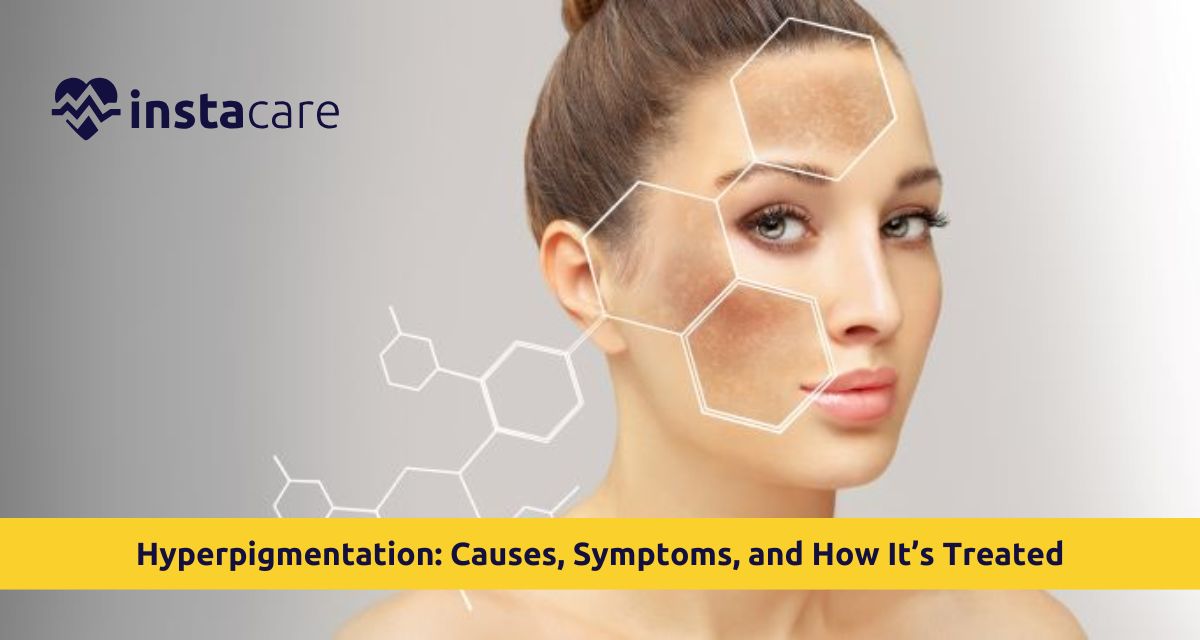Hyperpigmentation is the resulting effect of the overproduction of melanin, which tans the skin. Overproduction results in dark spots or patches compared to surrounding tissue. They are harmless but an aesthetic concern to most people. It is an ailment that occurs in the form of brown flat macules, either black or brown, depending on complexion intensity or severity. Hyperpigmentation on face is very prevalent but may occur anywhere on the surface of the body exposed to causative etiologies.
Common Causes of Hyperpigmentation
Sun Exposure
The most common agent to cause hyperpigmentation is ultraviolet light. The cause for a post-sun exposure melanin production is a protective response of the skin. Repeated exposure without covering results in abnormal melanin deposition forming sunspots and age spots.
Hormonal Changes
Hormonal change is the pathogenesis of
melasma, especially in women. During pregnancy, hormonal replacement, and hormonal contraceptives reverse melanin. Symmetrically appearing hormonal hyperpigmentation on the upper lip, forehead, and cheeks follows.
Post-Inflammatory Hyperpigmentation (PIH)
Skin fading by acne, eczema, cuts, or burns causes brown spots as the skin heals. Post-inflammatory hyperpigmentation is caused by inflammation and stimulates melanocytes to liberate excessive melanin. PIH is more pronounced in dark skin and will persist for months if left untreated.
Medications
Certain drugs cause photosensitizing increase in photosensitivity, thereby sensitizing the skin to darken upon exposure to the sun. Hyperpigmentation is caused as a therapeutic action by antibiotics, antimalarial, and anticancer drugs.
Aging
Physiologic aging mechanisms gradualist the response of the regulatory melanin-producing skin to balance. Cumulative damage inflicted by the sun after decade’s manifests on old people as spots of senility or age spots.
Types of Hyperpigmentation
Melasma
Melasma is brown or gray-brown face macules, usually. Melasma is sun- and hormonally caused and occurs most often in women and dark-skinned individuals. Hyperpigmentation vs melasma: all melasmas are hyperpigmentation, but not all hyperpigmentation is melasma only hormonal etiology is encompassed by melasma.
Sunspots (Solar Lentigines)
Also referred to as age spots, these are flat brown spots that are present on sun-damaged skin such as the face, hands, and shoulders. They are caused by cumulative sun exposure, representing one of the types of hyperpigmentation.
Post-Inflammatory Hyperpigmentation (PIH)
PIH causes brown lesions following healing of the skin after inflammation or injury. Overindulgence of the skin in acne zits, insect bites, or overexposure is most commonly the cause of this category. Color is reddish, brown, or black in color.
Freckles
Genetic heritage and sun exposure are the cause of these small, dense melanin spots. Though generally adorably thought of, most do eliminate it for more uniform skin.
Diagnosis and When to See a Dermatologist
Hyperpigmentation is most commonly diagnosed by appearance. Wood's lamp ultraviolet light that will illuminate melanin depth is also found in the dermatologist's for an opinion of severity and best treatment. Consult a dermatologist if enlarging hyperpigmentation sudden onset is also preceded by other signs or fails to clear after three months of treatment with over-the-counter measures. Sophisticated testing excludes life-threatening disease such as skin cancer.
Treatment Options
Topical Treatments
Hydroquinone remains the drug of choice for inhibition of melanin synthesis to avoid hyperpigmentation. For a prescription (4%) or over the counter (2%), the drug must be applied on a daily basis for 8-12 weeks.
Over the counter best products for hyperpigmentation include retinoids that induce cell turnover, serums of vitamin C that bleach the skin, kojic acid which prevents melanin production, Niacinamide that inhibits transfer of melanin, and Azelaic acid which also cures acne and pigmentation. Synergistic effects caused by combinations of active ingredients make up hyperpigmentation cream that are potent.
Chemical Peels
Professional peels are the application of glycolic acid, salicylic acid, or trichloroacetic acid to kill pigmented skin layers. Superficial peels need repeated use with minimal downtimes but very good results are achieved by deeper peels with extended downtimes, contributing to hyperpigmentation removal.
Laser Treatment for Hyperpigmentation
Q-switched lasers are used specifically to excise melanin deposits without damaging surrounding tissue. IPL is used for the treatment of diffuse pigmentation using wide wavelengths of action. Laser treatment for hyperpigmentation has to be repeated and ruthlessly continue to produce hyperpigmentation when used inappropriately, particularly on darker skin.
Microdermabrasion
Physical exfoliation brushes off the outer skin layers and, in the long term, removes surface pigment. Mild hyperpigmentation is best treated with it and needs to be repeated.
Micro needling
Tiny needles cause micro-wounds that induce collagen formation and enable deeper penetration of lightening creams into the skin. Micro needling is a useful method to treat recalcitrant discoloration if combined with vitamin C, addressing how to get rid of hyperpigmentation.
Natural and Home Remedies
Home remedies for hyperpigmentation provides milder versions, though the outcome takes a longer time than that the experts provide.
Vitamin C
Home treatments of hyperpigmentation utilize vitamin C in serums. Vitamin C is a DE pigmenting agent as it lightens the skin and protects it against future damage by its antioxidant action.
Aloe Vera
Aloin contained in aloe vera is also used to whiten hyperpigmentation. Use undiluted aloe gel over the affected area at night.
Green Tea Extract
Topical use of green tea extract rich in antioxidants prevents melanin formation.
Licorice Root
Glabridin from licorice prevents melanin formation. Use cosmetics containing licorice extract.
Natural remedies for hyperpigmentation take longer to work but are safer than medications. Be persistent and patient natural pathways take months to provide their effect.
Preventive Measures
Sun Protection with Hyperpigmentation
Prevent and correct hyperpigmentation with daily broad-spectrum SPF 30 sunscreen. Outdoors every two hours. Wide-brimmed hats and clothing also shield. Stay out of the sun between 10 AM and 4 PM. Even windows let UV light in, so cover inwards, too. Sun protection for hyperpigmentation is essential.
Gentle Skin Care
Skip harsh scrubbing and irritating procedures that cause inflammation and PIH. Use non-Comedogenic products that are well matched to your skin. Gradually add active ingredients.
Treat Skin Problems Early
Pimples, eczema, or inflammatory skin dermatoses if caught early may help avoid developing PIH.
Antioxidant Protection
Apply products containing
vitamins C and E, green tea extract, or Niacinamide. They counteract free radicals which initiate the release of melanin.
Myths vs. Facts About Hyperpigmentation
- Myth: Hyperpigmentation occurs only in dark skin Fact: Hyperpigmentation can occur in any skin but is more likely to occur with dark skin.
- Myth: Hyperpigmentation can be removed overnight Fact: It is a process that requires months of persistent work through hyperpigmentation treatment. All treatments at least 8-12 weeks before seeing some change.
- Myth: Hyperpigmentation will never come back once treated Fact: Without maintenance and continuous sun protection, hyperpigmentation returns.
- Myth: Natural remedies as quickly as doctor remedies Fact: Natural remedies are slow but less damaging, taking months instead of weeks to see real change.
Conclusion
Hyperpigmentation, though normal and otherwise benign, is quickly treated and prevented with proper prevention and treatment. No matter if the reason for the hyperpigmentation is sun damage, hormones, or inflammation; there are countless treatments for attaining brighter skin. Be patient and persistent most treatments take a couple of months to take phenomenal effect. Other than ordinary sun prevention, professional treatments are the most effective method to attain long-term control of hyperpigmentation and attainment of even-looking skin.
Please book an appointment with the
best Dermatologist in Lahore, Karachi, Islamabad, and all major cities of Pakistan through
InstaCare, or call our helpline at 03171777509 to find a verified doctor for your disease.

